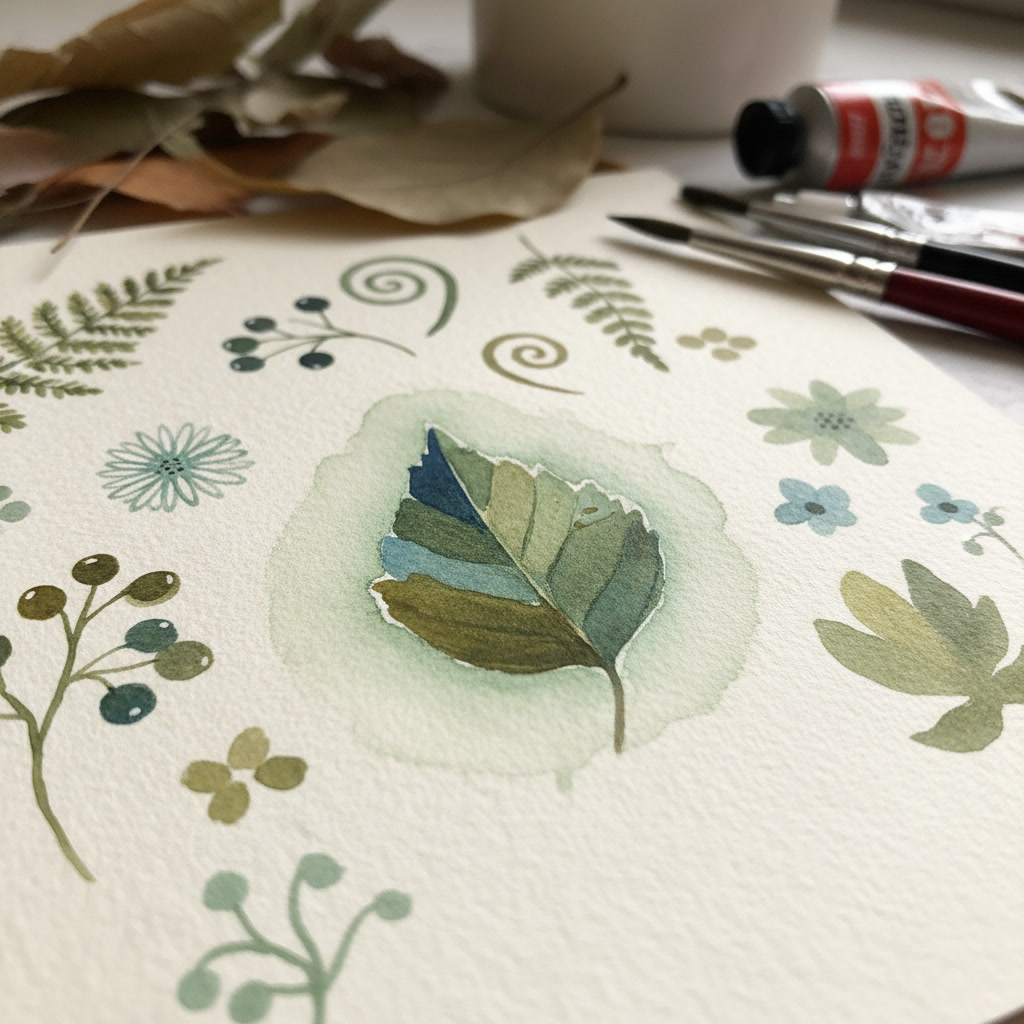At Lily & Inc Studio, every collection begins outdoors. We sketch among the leaves, press petals into notebooks, and let the rhythm of natural growth shape our hands before our designs ever touch a screen. Our botanical motifs are not imagined—they're observed. They carry the imperfections of real leaves, the unpredictable curves of stems, the quiet asymmetry that only nature can teach.
The process from sketch to textile print is where art meets discipline. Every brushstroke, scan, and stitch serves one purpose: translating the wild logic of the garden into the language of fabric.
Inspiration Begins in the Garden
Our design process always starts with presence. We visit local gardens, wild meadows, and botanical conservatories, sketchbooks in hand. Rather than hunting for beauty, we look for rhythm—the way a vine loops, how light filters through overlapping leaves, how decay can be as elegant as bloom.
Each designer on our team keeps a seasonal sketch journal. These sketches are loose, sometimes messy, but full of gesture. They capture the movement of nature, not its perfection. The goal is never realism—it's emotion.
We call this first step field observation, and it's the foundation of our fabric design process.


Translating Nature Through the Hand
Back in the studio, the sketches are spread across our long oak table. We analyze composition and balance, marking which lines carry energy and which shapes create rest. From there, we refine—reworking hand drawings in ink, watercolor, or digital stylus.
The key is restraint. We never trace nature literally; we interpret it. The curve of a fern might become a repeating rhythm, or the negative space between petals might inform an entire layout.
This is where our botanical print design philosophy lives: in the translation, not imitation, of nature.
From Sketch to Digital Canvas
Once we have a series of hand drawings that capture our theme, we begin digitizing. Each drawing is scanned at high resolution, cleaned carefully, and adjusted for tone. Our digital process is intentionally slow—we prefer to preserve the character of the brushstroke rather than smooth it out.
We work in layered compositions, arranging the motifs into patterns that feel both spontaneous and structured. Every repetition is tested at different scales to see how it behaves on fabric. A leaf too large can overwhelm; one too small can lose voice.
This stage is where the pattern development begins in earnest.
Choosing the Right Fabric Voice
Not every design belongs to every fabric. Some motifs crave texture, while others demand smoothness. During prototyping, we print the same design on different bases—linen, cotton, silk, and organic blends—to observe how the fibers interact with light and color.
Botanical designs thrive on tactile realism. A soft matte finish often enhances their organic charm, while a slight sheen can elevate them to quiet luxury. Choosing the right material is an emotional decision as much as a technical one.
We often say: the fabric must speak the same language as the motif.


Color Development — Nature's Palette, Refined
Color is never arbitrary in our work. We draw directly from our field sketches, sometimes even photographing petals to sample their pigment in digital form. But once translated to fabric, color must communicate emotion, not imitation.
For example, in our Verdant Silence series, we replaced natural greens with muted sage and clay tones—more atmospheric than literal. The result felt truer to the memory of nature than to nature itself. That's the art of emotional color translation.
Every hue is tested under both daylight and lamplight. We never finalize color until it feels right in both the eye and the hand.
The Art of Repetition — Finding Rhythm Without Predictability
A good botanical pattern should feel alive. Too much symmetry kills it; too much randomness weakens it. The challenge is to find that subtle irregularity—the human touch that machines can't mimic.
We often spend days adjusting the placement of a single leaf to make sure the pattern breathes. It's meticulous, almost meditative work. When it's right, you don't notice the repeat—you feel flow.
This stage is what separates a decorative print from a textile narrative.
Printing and Proofing — The Moment of Truth
Once the digital pattern is finalized, we print test swatches using eco-friendly inks. This stage feels like opening a gift—our sketches reborn in tactile form. The first proof rarely matches the screen; sometimes the pigment deepens, sometimes the texture shifts. We adjust accordingly, balancing fidelity with surprise.
This is where craftsmanship meets chemistry. Understanding how pigment interacts with fiber is as much science as it is intuition.
Our print partners know we're particular—we test until it's perfect, but never polished beyond character.

Finishing Touches — From Cloth to Collection
After final approval, the fabrics are washed, pressed, and documented. Each pattern receives a handwritten name and story in our studio log. The narrative matters as much as the weave.
The finished textiles enter our collection as living records of our process: sketches, revisions, and countless conversations distilled into cloth. We believe that authenticity shows in the final product—not as a marketing angle, but as visible integrity.
Why Process Matters More Than Perfection
Our botanical prints are not about flawless reproduction. They're about preserving the human hand in a digital era. Every irregular mark, every tonal shift, reminds us of where the idea began—among dirt, wind, and light.
That's why process matters. It's not just the means to an end—it's the art itself.
Continuing the Conversation
We hope this glimpse into our fabric design process helps others see textiles not as static surfaces, but as evolving narratives. Each motif we create grows from a seed of observation into a piece of material storytelling.
Our garden never really ends—it just changes form.
Want to collaborate with Lily & Inc Studio on your next botanical or custom textile project?
Work with us



